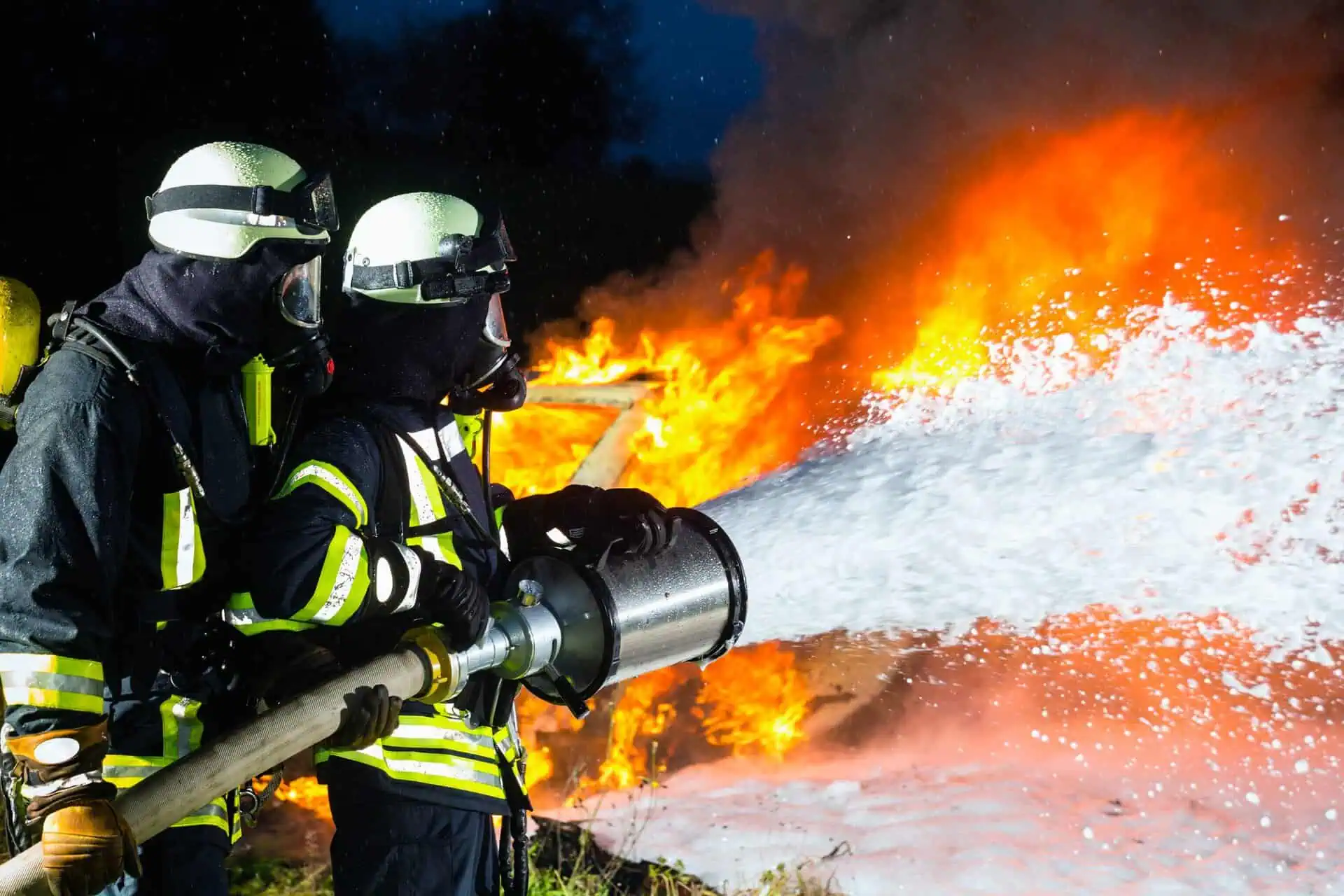AFFF Lawsuit: Significance of Empowering Firefighters
- Last Updated: June 12th, 2025

Attorney Jessica Paluch-Hoerman, founder of TruLaw, has over 28 years of experience as a personal injury and mass tort attorney, and previously worked as an international tax attorney at Deloitte. Jessie collaborates with attorneys nationwide — enabling her to share reliable, up-to-date legal information with our readers.
Legally Reviewed
This article has been written and reviewed for legal accuracy and clarity by the team of writers and legal experts at TruLaw and is as accurate as possible. This content should not be taken as legal advice from an attorney. If you would like to learn more about our owner and experienced injury lawyer, Jessie Paluch, you can do so here.
Fact-Checked
TruLaw does everything possible to make sure the information in this article is up to date and accurate. If you need specific legal advice about your case, contact us by using the chat on the bottom of this page. This article should not be taken as advice from an attorney.
Key takeaways:
- AFFF lawsuits help firefighters fight back against health risks from toxic firefighting foam exposure.
- These cases are crucial in making manufacturers of the harmful foam accountable and urging them to make safer products.
- The legal actions also raise awareness about dangerous fire - suppression alternatives, advocating for healthier choices.
AFFF Lawsuit Significance of Empowering Firefighters
On this page, we’ll discuss the impact of the AFFF Lawsuit on firefighter training, the significance of empowering firefighters through the AFFF Lawsuit, who qualifies to file for an AFFF Lawsuit, and much more.
The Significance of Empowering Firefighters
Firefighters face numerous risks, but exposure to Aqueous Film Forming Foam (AFFF) might be the most overlooked.
Scientific studies have recently discovered a link between AFFF firefighting foam and an increased risk of cancer, amongst other health problems.
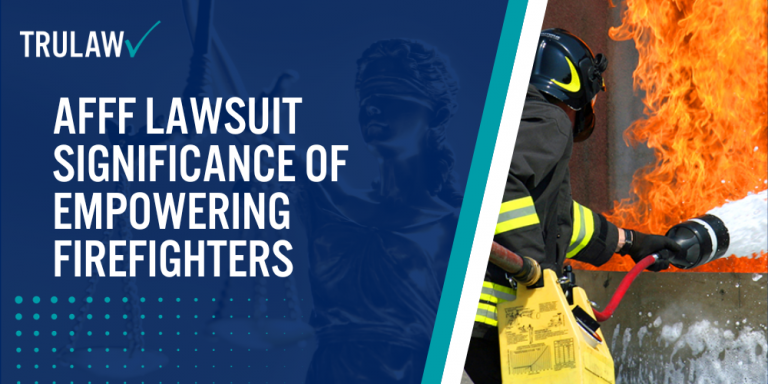
This exposure to AFFF primarily occurs during firefighter training and emergency responses, where AFFF is used for extinguishing fuel-based fires.
As a result, firefighters who have frequently interacted with this foam are at a higher risk for developing serious health conditions, emphasizing the importance of the AFFF Lawsuit.
Table of Contents
AFFF Lawsuits: Empowering Firefighters with Legal Recourse
AFFF lawsuits serve as an important tool in empowering firefighters with legal recourse.
These cases play a crucial role in holding manufacturers of toxic firefighting foam responsible for the health risks they pose.
The mounting legal challenges force corporations to reevaluate their products, focusing on safety and environmental responsibility.
Firefighters have always been on the front lines, constantly exposed to AFFF, a blend of toxic chemicals that includes PFAS resulting in various forms of cancer and other occupational hazards.
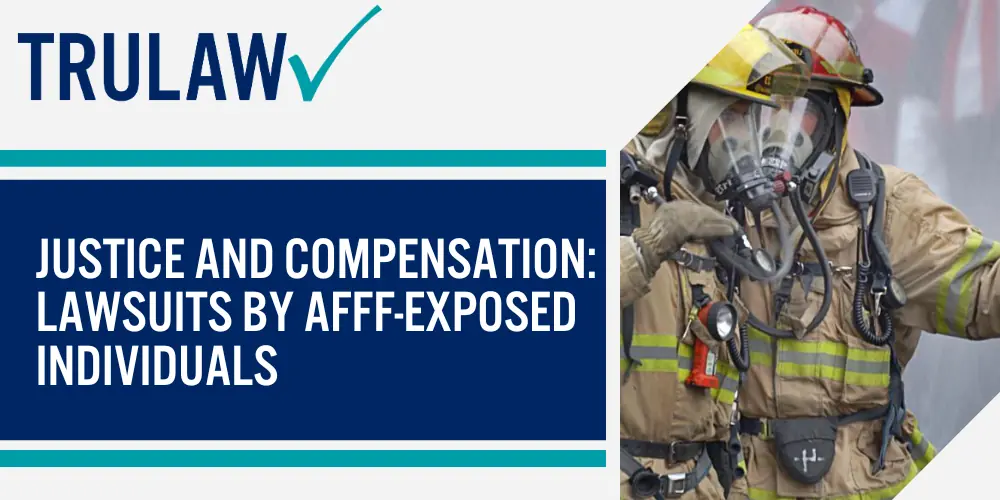
These brave individuals exercise their right to justice through lawsuits, seeking compensation for injury and disease linked directly to exposure from AFFF firefighting foams.
These suits illuminate past corporate irresponsibility and forge a path toward better firefighter training techniques and gear improvement.
Lawsuits stimulate innovations to prevent future chemical exposure-related mishaps while promoting more robust safety measures during training exercises.
Aside from this, AFFF lawsuits foster community engagement by opening dialogue about healthy fire suppression alternatives free from harmful toxins such as PFAS compounds embodied within regularly used firefighting foams.
In terms of advocacy for firefighter rights—these AFFF lawsuits stand tall as catalysts enhancing legislative protection efforts against negligent corporate behavior—and strengthening regulations governing chemical usage in fire suppressants foreseen through compliance.
Finally, yet importantly, through these landmark legal initiatives, we witness tangible proof towards efficient progression—an environment fostering healthier firefighters alongside safer communities around us all—all because those impacted decided the future should hold better prospects than what’s behind.
Fighting Back: How AFFF Lawsuits Empower Firefighters
AFFF lawsuits grant firefighters a powerful tool to fight back.
These legal actions primarily target manufacturers like 3M and DuPont, who produced an aqueous film-forming foam (AFFF) that is now linked to increased cancer risks among those exposed, especially firefighters.
The lawsuits aim to gain compensation for individual victims’ medical expenses and suffering and ignite change in industry practices.
Through these suits, lawmakers are prompted to enact tighter regulations on such hazardous substances while companies are pressured into innovating safer firefighting technologies.
Consequently, these legal proceedings foster a more protected environment for these brave men and women dedicated to public safety.
Legal Protections and Firefighter Empowerment Through AFFF Lawsuits
AFFF lawsuits are increasingly empowering firefighters, providing them with the legal protections necessary to fight back against potential harm caused by chemicals in firefighting foam.
As thousands of these legal actions emerge nationwide, a pronounced shift is occurring towards holding manufacturing giants such as 3M and DuPont accountable for PFAS contamination.
A major benefit of this litigation process is its significant role in raising awareness about the issues related to AFFF exposure.
Firefighters now find themselves better equipped with knowledge and resources, allowing them to push forward their demands for safer alternatives and more rigorous health protocols.
This empowerment through litigation comes from individual claims and class-action suits, which stress solidarity amongst those affected.
With an increasing number of occupations exposed to toxic firefighting foam choosing to file AFFF lawsuits, there’s a growing sense of support and unity, strengthening the collective voice demanding justice against unregulated chemical exposures that risk their health every day at work.
AFFF Lawsuits and Firefighter Health in Lifesaving Connection
AFFF lawsuits serve as an essential defense line for firefighters, their health is directly linked to these legal actions.
Exposure to Aqueous Film Forming Foam (AFFF) during firefighting activities has reportedly increased the risk of serious medical illnesses among professionals in this field.
Higher-than-average cancer rates, notably prostate and testicular cancer, have been prevalent amongst firefighters; a dire situation attributed mainly to toxic chemicals present in AFFF.
Manufacturers such as 3M allegedly concealed the hazardous nature of PFAS chemical compounds found in firefighting foam products—an oversight that has spurred numerous lawsuits.
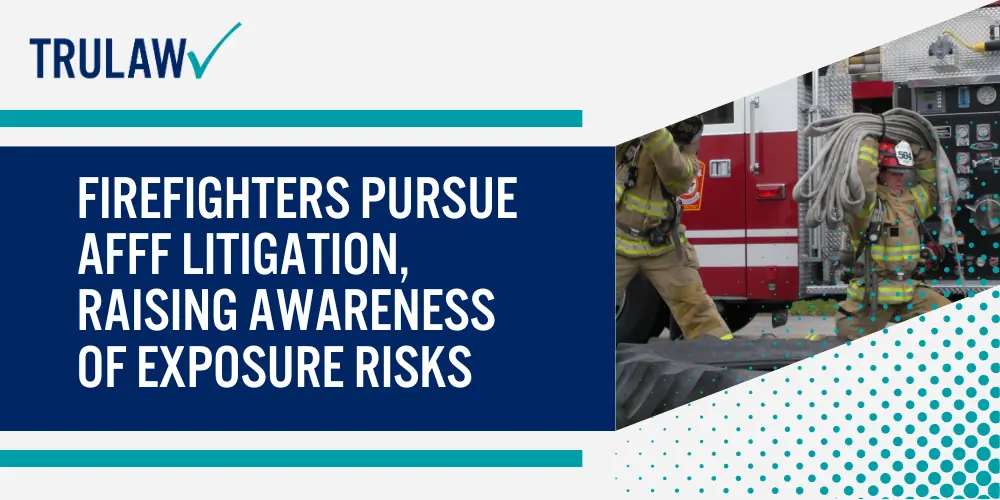
As early as the 1990s, evidence emerged linking PFAS exposure with adverse health effects like kidney and thyroid cancers but was knowingly overlooked by major manufacturers.
Today, many firefighters pursue justice through AFFF litigation while empowering their community with information about occupational exposure risks associated with toxic firefighting foams.
The principal aim is not only to seek financial compensation but also to ensure safer environments for our brave lifesavers.
Preserving Lives: The Crucial Link Between Firefighter Health and AFFF Lawsuits
Firefighters bear an inescapable risk whenever they don their gear and head into a blaze.
This danger increases manifold when one considers the role of Aqueous Film Forming Foam (AFFF), which has been widely utilized in firefighting practices across the globe.
There’s no denying that AFFF helps combat dangerous fires effectively, but recent lawsuits have brought to light the serious health implications of prolonged exposure to this foam.
Indeed, mounting evidence shows a strong correlation between consistent contact with AFFF and several types of cancer, along with other adverse health effects.
The high levels of per- and poly-fluoroalkyl substances (PFAS) found within these foams are believed to be the culprit behind such alarming health consequences.
Manufacturers like 3M face a substantial legal backlash as lawsuits allege they had prior knowledge about these risks yet failed to release adequate warnings or safety measures for firefighters’ protection, putting countless lives at stake.
Through these lawsuits, firefighters now have a means not only to seek justice but also to spread awareness within their community about the potential dangers lurking behind seemingly harmless firefighting tools — thereby preserving more lives in the long run.
AFFF Lawsuits as Lifesavers: Firefighter Health Protection
Firefighters face a variety of hazardous conditions daily, but exposure to Aqueous Film Forming Foam (AFFF) presents an insidious risk.
Known for extinguishing jet fuel fires effectively, AFFF has been used widely across the firefighting industry.
However, PFAS chemicals found in this toxic foam have been linked to multiple health concerns including prostate cancer and other adverse health effects.
Recognizing this threat, firefighters are beginning to fight back through legal channels.
By filing lawsuits against manufacturers like 3M and DuPont who failed to warn about potential health risks associated with their product usage, they aim to draw attention to this critical issue.
AFFF lawsuits serve as crucial lifelines in not only seeking financial compensation for damage done but also in driving change within the industry itself.
In an effort to safeguard firefighter health protection rights and hold corporations accountable for their actions or lack thereof, these lawsuits are leading the charge toward establishing safer practices across the firefighting fraternity.
The cases demand alternative solutions that don’t compromise on efficiency or put hardworking firefighters’ lives at unnecessary risk.
This pressing issue also underscores the drastic need for compliance changes at regulatory levels which can empower firefighters to navigate around AFFF-free regulations and mandates more effectively.
AFFF Lawsuits Impact on Firefighter Training and Preparedness
The AFFF lawsuits have triggered a transformation in firefighter training and readiness.
Manufacturers including 3M and DuPont are now in the legal spotlight for their alleged attempts to manipulate independent testing results.
Firefighters used to rely heavily on AFFF firefighting foam during both actual fire emergencies and training activities.
However, the discovery of harmful chemicals linked with cancer and other health issues in these foams has shifted this dynamic.
Exposure from years of using this toxic firefighting foam is no small issue, as it puts many at risk, especially firefighters who’ve had routine contact with it.
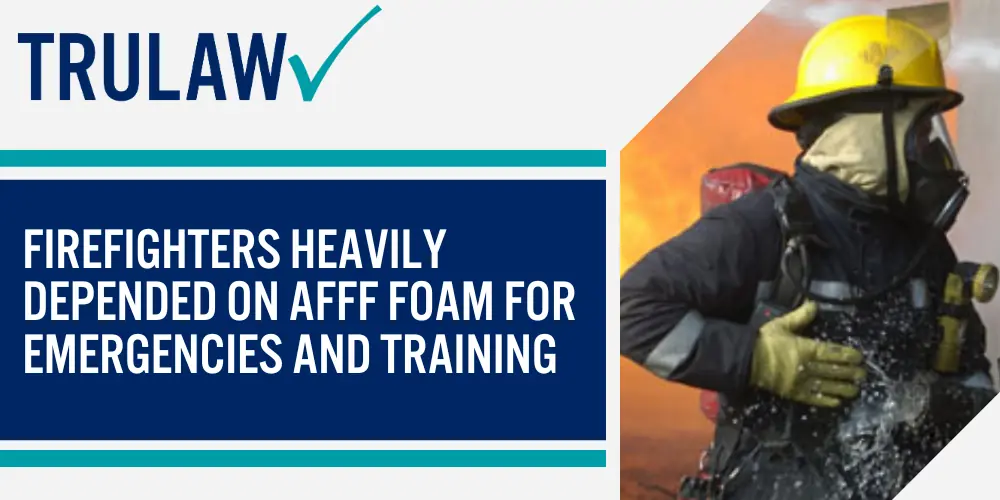
Due to these lawsuits, substantial changes have been made across fire departments nationwide concerning training protocols.
Firefighting foam products previously containing PFAS are being substituted with safer alternatives where possible.
Departments are focusing more on improving safety measures during drills involving firefighting foams and educating their crew about potential health risks related to AFFF exposure.
Moreover, the International Association of Firefighters has taken significant steps beyond training reforms; they’ve accused the National Fire Protection Association of necessitating PFAS usage in firefighter gear itself!
As such advocacy continues through class-action MDL suits filed against companies like 3M or Tyco Fire Products amongst others on behalf of affected personnel – be they firefighters, military members, or airport workers – there’s evident resilience among those seeking justice around AFFF-related toxicity hazards.
Enhancing Preparedness: AFFF Lawsuits’ Influence on Firefighter Training
AFFF lawsuits have brought critical changes to firefighter training.
The legal battles highlighted the dangers of Aqueous Film-Forming Foams (AFFFs) causing departments across the country to reconsider their use in drills and real-life emergencies.
Firefighters now undergo comprehensive safety courses about potential health hazards associated with AFFF exposure, enhancing their preparedness on how to handle such materials safely during operations.
This shift towards safer practices not only protects firefighters but also plays a significant role in reducing environmental pollution caused by these foams.
New training simulations are being developed that limit direct contact with harmful substances, utilizing advanced technology for realistic firefighting scenarios without compromising safety or effectiveness.
In this way, AFFF lawsuits serve as catalysts for improving occupational safety regulations and procedures within the firefighting community.
Training for Safety: How AFFF Lawsuits Shape Firefighter Preparedness
Litigation surrounding Aqueous Film Forming Foam (AFFF) has incited advancements in firefighter training protocols.
These lawsuits underscore the importance of safety measures to protect against hazards linked with AFFF exposure, fostering a more prepared and vigilant firefighting environment.
Firefighters are now receiving education on potential health risks associated with occupational exposure to this toxic firefighting foam.
With awareness heightened by ongoing litigation, they can better identify symptoms tied to AFFF-associated ailments like prostate cancer, kidney cancer, or thyroid disease.
Adaptive responses to these lawsuits have also led fire departments across the nation to implement AFFF-free practices into their standard operating procedures.
This shift reduces unnecessary exposure during routine drills without compromising performance or efficiency in extinguishing jet fuel fires.
Further, firefighters are taught about their rights related to possible adverse health effects from using AFFF products in the line of duty.
Empowering them with such knowledge equips these brave individuals and affords them the ability to take action should they develop conditions as a result of hazardous workplace exposures.
AFFF Lawsuits Environmental Awareness and Firefighter Empowerment
AFFF lawsuits reveal the environmental implications of using firefighting foams and promote vigilance among firefighters.
They underscore the importance of adopting safer, eco-friendly alternatives to AFFF firefighting foam.
The litigation draws attention to PFAS contamination due to AFFF usage in firefighter training and emergency response scenarios.
These revelations play a key role in fostering environmental stewardship within fire departments nationwide.
Firefighters become empowered as they gain more knowledge about potential health hazards associated with their occupation.
This awareness enables them to champion for their rights and advocate for safer working conditions —free from exposure to harmful substances like PFAS chemicals present in AFFF firefighting foam.
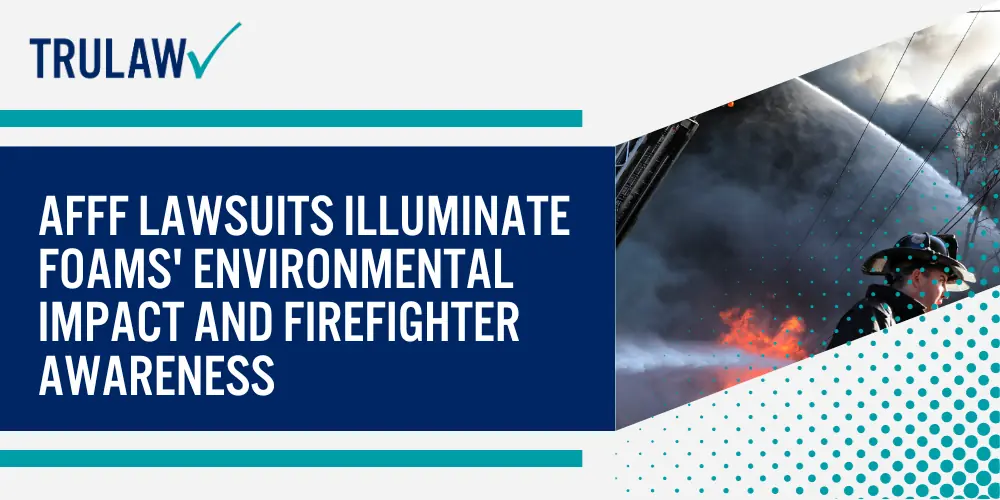
Thus, these lawsuits have given rise to an era of enlightenment and empowerment, steering the future towards cleaner practices that protect both human health and our precious ecosystem.
Environmental Stewardship: AFFF Lawsuits Empower Firefighters
Firefighters shoulder the responsibility of safeguarding communities while also caring for the environment.
AFFF lawsuits play an essential role in this environmental stewardship by providing a way to hold manufacturers accountable for damages caused by toxic firefighting foams.
These legal actions have spotlighted the need for safer, more eco-friendly firefighting practices and materials.
The environmental impact of PFAS-containing foams is severe, contaminating groundwater and affecting wildlife habitats.
Through these lawsuits, firefighters are not just seeking compensation but leading a fight against chemical industry negligence that jeopardizes our natural resources.
The result is a stronger push towards environmentally responsible techniques that protect both citizens and nature from potential harm.
Raising Awareness: Firefighter Empowerment via AFFF Lawsuits
AFFF lawsuits serve as a powerful catalyst for raising awareness about the health risks associated with firefighting foams.
These legal battles expose the harmful impacts of PFAS chemicals, long-term occupational exposure to which can lead to serious health conditions such as prostate cancer, kidney cancer, and thyroid cancer among firefighters.
This increased knowledge empowers firefighters by giving them the information they need to take proactive steps towards protecting their wellbeing.
Equipped with this newfound awareness, many firefighters are stepping up to champion safer practices in their profession.
They’re advocating for AFFF-free alternatives, pushing for stricter regulations on toxic substances like those found in AFFF foams, and fighting for greater transparency from manufacturers about potential hazards posed by their products.
Through these efforts, firefighters transform unsettling realities into impactful change – demonstrating that empowerment often arises from adversity.
To support these endeavors further, it’s critical to continuously spread information regarding AFFF laws around communities nationwide!
AFFF Lawsuits Safety Innovations on on how to Drive Equipment Upgrades
Through AFFF lawsuits, the spotlight is shining brighter on the need for superior safety measures in firefighting.
The litigation brings to light the reality of hidden danger that may be lurking within commonly used fire suppressants, prompting a push for safer alternatives and equipment upgrades.
Manufacturers and researchers break new ground in improving firefighting gear with innovative technologies inspired by these legal battles.
Helmets, suits, gloves – across all facets of firefighter equipment – strive for premium protection without risks associated with harmful substances like PFAS chemicals found in traditional foams.
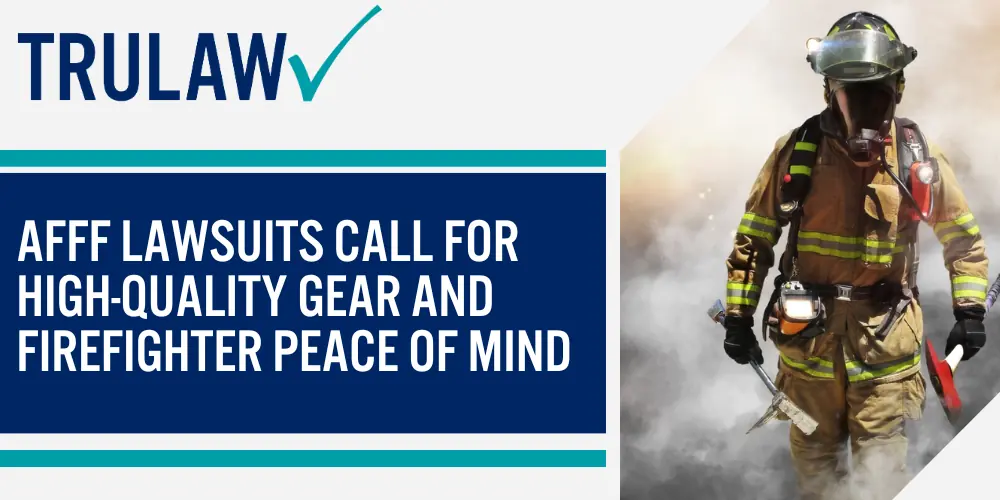
The call echoes loud from AFFF lawsuits – providing our fearless first responders with both top-performing gear and peace of mind about their health and safety.
In response to this demand, industry leaders are stepping up their game.
They’re developing durable yet chemical-free tools; they’re implementing more efficient designs aimed at reducing hazardous exposure; they’re revolutionizing breathing apparatuses to combat harmful smoke inhalation.
Innovations spurred by AFFF litigations not only enhance firefighters’ performance but also help protect them from long-term occupational hazards.
As such advancements continue unabated, we inch closer to an era defined by enhanced safety standards embracing protective practices while eradicating harmful elements.
AFFF Lawsuits Fuel Innovation: Firefighting Equipment Upgrades
Lawsuits confronting manufacturers of Aqueous Film Forming Foam (AFFF) have sparked significant changes in the firefighting industry.
To ensure firefighter safety, these legal battles have heavily influenced equipment upgrades and advancements.
The demand for safer gear is more apparent than ever due to the ongoing exposure risks that caused a surge in health-related lawsuits from firefighters.
Consequently, manufacturers are driven to innovative designs, using materials that secure protection against harmful substances such as PFAS found in AFFF products.
This shift not only improves firefighter safety but also redefines standards within the industry by placing greater emphasis on innovations focused on ensuring frontline personnel’s wellbeing.
Furthermore, allegations regarding defendants’ knowledge about PFAS-associated health problems have accelerated efforts in research and development of alternative firefighting agents with reduced toxicity levels, providing rounded protection for our brave men and women on the front lines.
Equipping for Safety: The Influence of AFFF Lawsuits
AFFF lawsuits are shaping the safety landscape for firefighters.
As litigation exposes the health risks associated with Aqueous Film Forming Foam (AFFF), there’s a growing concern to equip our first responders with safer alternatives.
Manufacturers of firefighting gear take notice as these legal battles put pressure on the industry, encouraging innovation and development of low-risk equipment and substances.
The evolution in firefighting technology is an unintended yet highly beneficial outcome of these lawsuits, steering away from hazardous materials like PFAS chemicals found in traditional AFFFs.
With potential settlement payouts looming over leading manufacturers who knowingly risked firefighter health, increased emphasis is placed on product safety moving forward.
Consequently, fire departments across America are now re-evaluating their equipment inventory to reduce exposure rates among their rank while ensuring optimal performance during rescue missions.
AFFF Lawsuits and Community Engagement and Raising Awareness
AFFF lawsuits are not merely legal battles, they are catalysts for growing community awareness and engagement.
These suits underline the consequences of PFAS contamination on public health and intensify social consciousness about environmental safety norms.
Coupled with effective media reporting, AFFF lawsuits amplify voices of firefighters impacted by hazardous firefighting foams used in their line of duty.
Active participation from individuals contributes to a larger dialogue around firefighter’s rights, toxic exposures, and necessary changes needed in firefighting practices.
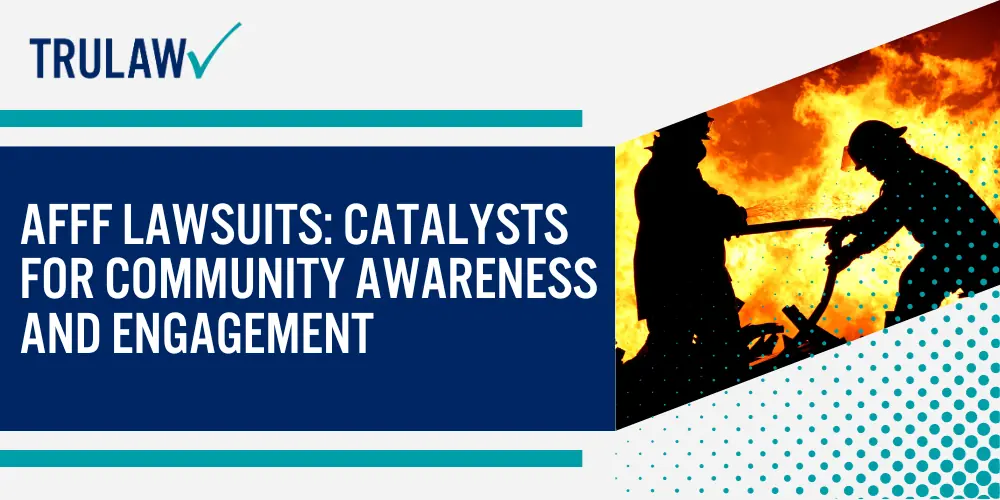
Community members rally together in support of these brave men and women who risk their lives every day.
This robust level of engagement also pressures corporations involved in producing harmful products to reconsider their actions and prioritize public welfare over profit margins.
Building Awareness: AFFF Lawsuits and Community Engagement
Community involvement is a pivotal element in the narrative surrounding AFFF Lawsuits.
Firefighters are turning to their local communities, sharing their experiences and educating about the risks associated with firefighting foam.
The conversation is prompting a surge of local advocacy and driving crucial changes toward safer practices.
Through public forums and awareness campaigns, informed citizens are amplifying this issue on a national scale, pushing for stricter regulations on toxic substances found in AFFF.
This collective action shows that everyone has the power to make real change happen while protecting our brave firefighters from harmful exposure.
Community Partnerships: Spreading Awareness via AFFF Lawsuits
Community partnerships play a crucial role in drawing attention to AFFF lawsuits.
These collaborations involve a wide range of stakeholders including firefighting organizations, health advocates, and legal experts.
Together they work diligently to enlighten masses about the risks associated with aqueous film forming foam (AFFF).
Their joint efforts extend beyond just raising consciousness; they strive towards empowering firefighters – the most affected group by advocating better safety measures.
The partnerships also contribute to public education campaigns that highlight potential health dangers linked to AFFF exposure, cancer associations and preventive actions.
Through these strategic alliances, communities join forces in their pursuit of justice for those impacted by toxic firefighting foam hazards and make strides towards a safer future for all firefighters.
AFFF Lawsuits Advocacy for Firefighter Rights
AFFF lawsuits are a powerful tool for firefighters, offering them legal recourse against the manufacturers of harmful AFFF.
These lawsuits enable firefighters to stand up for their rights and demand accountability from companies like 3M and DuPont which knowingly put their health at risk.
The goal is not just compensation but also to inspire industry-wide change.
Firefighters across the nation affected by exposure to AFFF are filing these lawsuits, demanding justice.
They serve as advocates not only for themselves but for all present and future firefighters who might face similar risks on duty.
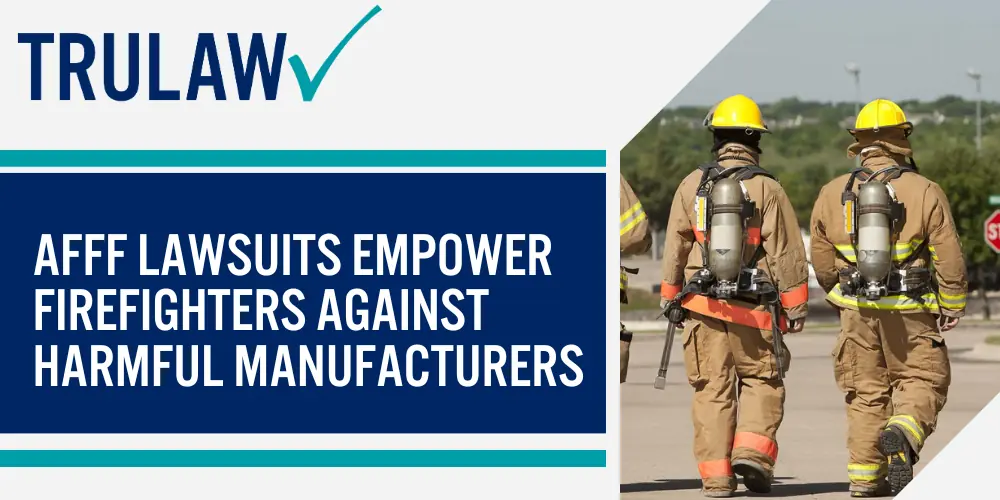
This advocacy sends a message about the serious consequences of carelessly jeopardizing firefighter health, leading towards safer practices in firefighting techniques and equipment use going forward.
Championing Firefighter Rights: AFFF Lawsuits’ Advocacy Role
AFFF lawsuits have emerged as powerful advocacy tools for firefighters’ rights.
These legal actions challenge the creators and manufacturers of Aqueous Film Forming Foam (AFFF).
They demand justice for hardworking firefighters who risks their lives to keep communities safe, yet face severe health consequences due to AFFF exposure.
The lawsuits put pressure on legislative bodies, compelling them to enact stricter regulations that prioritize firefighter safety over industrial convenience.
Through these efforts, AFFF lawsuits are not only seeking compensation for affected individuals but are also championing preventative measures to safeguard others from potential harm.
This highlights the key role of such lawsuits in advocating and protecting the rights of our brave firefighters.
AFFF Lawsuits as Advocacy Tools: Protecting Firefighter Rights
Firefighters consistently expose themselves to peril, all in the name of community safety.
This dedication should not come with added health risks due to chemicals found in firefighting foam like AFFF.
Lawsuits against manufacturers such as 3M and DuPont highlight this issue by advocating for the rights and safety of firefighters who’ve suffered from exposure.
They push manufacturers to develop safer alternatives, instigate policy adjustments, and drive equipment upgrades that mitigate exposure risks.
Advocacy via these lawsuits has proved effective in empowering firefighters, promoting their rights, and improving overall conditions in their line of work.
AFFF Lawsuit: Compliance For Future Empowerment
Firefighters now navigate a landscape full of regulations aimed at phasing out AFFF use due to its potential health risks.
Anticipating and adapting to these regulations is imperative in maintaining operational effectiveness while enhancing firefighter safety.
Legal recourse through AFFF lawsuits advocates for this change, pushing for compliance with safer alternatives. These cases propel the movement toward a healthier future for firefighters and their communities.
Their courage instigates vital discussions and actions surrounding hazardous substances used in firefighting, further empowering firefighters to advocate for their health rights more effectively than ever before.
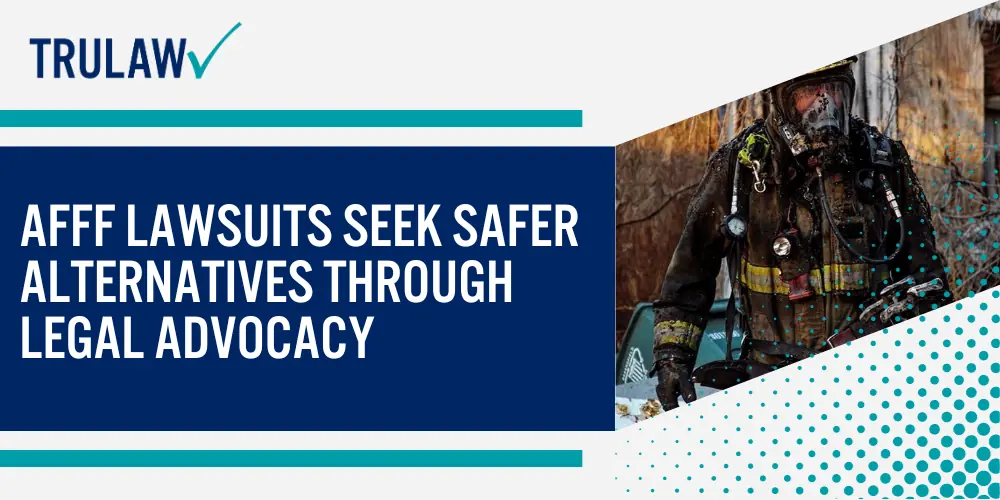
Compliance and Empowerment: AFFF-Free Firefighting Efforts
As industries shift towards AFFF-free firefighting initiatives, compliance plays a huge part in this transition.
Manufacturers are now taking responsibility for their products, focusing on minimizing harm and maximizing safety for both people and the environment.
Rapid advancements in firefighting technology have made it possible to phase out harmful substances like AFFF firefighting foams.
This signifies massive strides being taken by manufacturers in complying with environmental standards.
Empowerment too is becoming an integral facet of these efforts.
Firefighters, who were once victims due to exposure to toxic AFFF foam, now stand as champions of change within their ranks.
They are leading the push for safer alternatives, underlining their commitment to health protection while carrying out heroic acts every day.
Both firefighters and legal professionals are teaming up to promote awareness about the risks associated with certain kinds of firefighting foams while advocating for safer practices.
Empowering Firefighters: Navigating AFFF-Free Regulations
Transitioning to AFFF-Free operations is vital in enhancing firefighter safety and health.
This significant shift protects firefighters from the harmful effects of AFFF linked to several types of cancer and adverse health impacts.
Firefighters are now harnessing knowledge about PFAS exposure risks associated with the foam as a tool for empowerment, asserting their right to a safer working environment.
In this new era, firefighters are becoming adept at navigating AFFF-free regulations.
They learn about alternative firefighting methods that pose minimal risk to their health while remaining effective against fires.
As they embrace these safer practices, they blaze a trail for the rest of the industry, shedding light on critical issues surrounding occupational safety within fire services worldwide.
AFFF Lawsuit Legal Initiatives to Promote Firefighter Empowerment
Legal initiatives related to AFFF lawsuits are making significant strides toward promoting firefighter empowerment.
These efforts aim to hold manufacturers of Aqueous Film Forming Foam accountable for the health risks associated with its use.
Lawsuits are currently in progress across the nation, championing the rights of firefighters and seeking justice for those who have faced serious medical issues due to exposure.
These legal actions not only provide financial support but also contribute towards policy changes, thereby empowering firefighters.
They encourage safer practices within fire departments and simultaneously work towards creating protective legislation for firefighters at risk from toxic chemicals such as PFAS found in AFFF products.
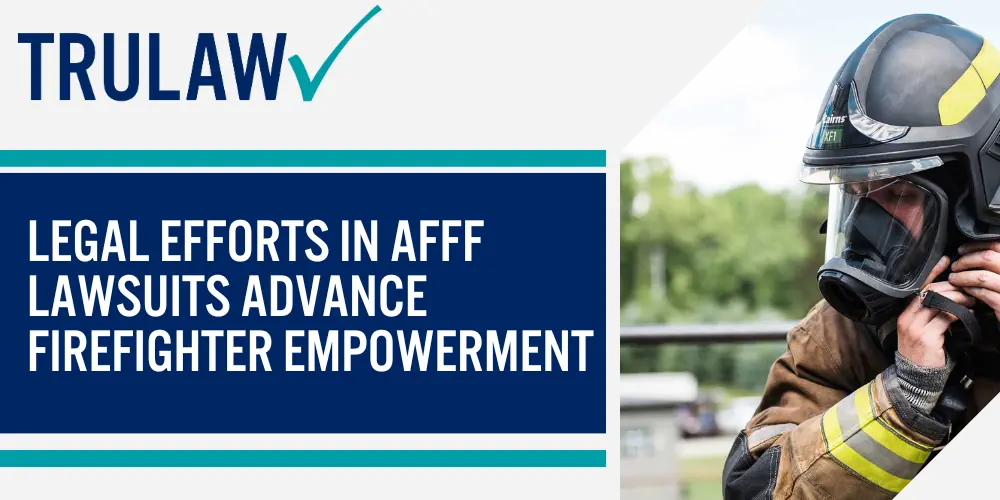
Ultimately, these actions are pivotal in shifting power back into the hands of those serving on our frontlines against fires.
Promoting AFFF-Free Practices: Legal Initiatives and Firefighter Empowerment
Lawsuits related to aqueous film-forming foam (AFFF) are driving significant change in firefighting practices.
These legal initiatives pave the way for safer alternatives, shifting away from harmful AFFF use.
Firefighters now have stronger advocacy and support due to these lawsuits.
The progress has empowered firefighters, giving them a voice against manufacturers who failed in their duty of care by using toxic substances without appropriate warnings.
The legal victories help bolster firefighter safety regulations while maintaining effectiveness.
Through constant push for AFFF-free practices, firefighters continue to protect lives and property without risk to their own health or damaging environmental sustainability efforts.
Empowering Firefighters through Legal AFFF-Free Initiatives
AFFF-free initiatives are growing in strength and support, driven by the determination to protect firefighters from the harmful effects of aqueous film-forming foam.
Firefighters’ exposure to this toxic foam has been linked to several kinds of cancer, putting their lives at risk even when they’re not facing flames.
AFFF lawsuits play a significant role in empowering them legally, ensuring they receive justice for their unnecessary exposures and associated health risks.
Through these legal efforts, firefighting departments are becoming more vigilant about adopting safer alternatives and approaches towards firefighting emergencies.
These AFFF-free initiatives highlight the importance of chemical safety while also fostering an environment that prioritizes firefighter welfare over outdated practices.
With increasing awareness and advocacy, these legal structures help drive change within firehouses nationwide, shaping regulations, training protocols and equipment usage towards safer use plus minimizing hazardous substance exposure across all activities.
Conclusion
AFFF lawsuits are a beacon of hope and empowerment for firefighters nationwide.
They symbolize the strong fight against negligence from manufacturers, paving the path for safer firefighting practices.
The significant impact of these lawsuits transcends justice and compensation by stimulating essential changes in industry regulations, training improvements, environmental awareness and advocating firefighter rights.
Last but not least, AFFF lawsuits pave the way for innovations that promote health preservation amidst hazardous duties.
AFFF Lawsuit Frequently Asked Questions
-
Can I File an AFFF Lawsuit if I Have Been Exposed to Firefighting Foam and Developed Cancer?
Yes, those who have been exposed to AFFF firefighting foam and have developed cancer can consult with a law firm or attorney specializing in such cases to file an AFFF firefighting foam lawsuits.
-
Are There Class action Lawsuits Around this Issue?
Class action suits like the AFFF class action MDL involve many plaintiffs-frequently including municipal water contamination cases- aiming for a common settlement from manufacturers of fire-fighting foams containing ‘forever chemicals’.
-
Who Are The Most Prominent Defendants in These Lawsuits?
Manufacturers targeted include companies whose product was incorporated into national firefighter registry due mostly to their links with developing cancer over periods of use; they are often defendants in pending AFFF lawyers in lawsuits.
-
What Kind of Settlements Have Previous Mass Tort Cases Achieved?
While specific figures vary case-by-case, Personal injury claims along with environmental working group initiatives could potentially yield sizeable AFFF lawsuit settlement amounts for victims from relevant responsible parties.
-
How Does South Carolina Feature Prominently in These Lawsuits?
South Carolina hosts numerous multidistrict litigation (known as AFFF MDL) related to these kinds of suits – including one significant case, City Of Stuart v major chemical companies that produced toxic components found within common Firefighting Foam blends thereby causing widespread harm on unknowingly affected communities.

Managing Attorney & Owner
With over 25 years of legal experience, Jessica Paluch-Hoerman is an Illinois lawyer, a CPA, and a mother of three. She spent the first decade of her career working as an international tax attorney at Deloitte.
In 2009, Jessie co-founded her own law firm with her husband – which has scaled to over 30 employees since its conception.
In 2016, Jessie founded TruLaw, which allows her to collaborate with attorneys and legal experts across the United States on a daily basis. This hypervaluable network of experts is what enables her to share the most reliable, accurate, and up-to-date legal information with our readers!
Additional AFFF Lawsuit resources on our website:
Here, at TruLaw, we’re committed to helping victims get the justice they deserve.
Alongside our partner law firms, we have successfully collected over $3 Billion in verdicts and settlements on behalf of injured individuals.
Would you like our help?
At TruLaw, we fiercely combat corporations that endanger individuals’ well-being. If you’ve suffered injuries and believe these well-funded entities should be held accountable, we’re here for you.
With TruLaw, you gain access to successful and seasoned lawyers who maximize your chances of success. Our lawyers invest in you—they do not receive a dime until your lawsuit reaches a successful resolution!
AFFF Lawsuit claims are being filed against manufacturers of aqueous film-forming foam (AFFF), commonly used in firefighting.
Claims allege that companies such as 3M, DuPont, and Tyco Fire Products failed to adequately warn users about the potential dangers of AFFF exposure — including increased risks of various cancers and diseases.
Depo Provera Lawsuit claims are being filed by individuals who allege they developed meningioma (a type of brain tumor) after receiving Depo-Provera birth control injections.
A 2024 study found that women using Depo-Provera for at least 1 year are five times more likely to develop meningioma brain tumors compared to those not using the drug.
Suboxone Tooth Decay Lawsuit claims are being filed against Indivior, the manufacturer of Suboxone, a medication used to treat opioid addiction.
Claims allege that Indivior failed to adequately warn users about the potential dangers of severe tooth decay and dental injuries associated with Suboxone’s sublingual film version.
Social Media Harm Lawsuits are being filed against social media companies for allegedly causing mental health issues in children and teens.
Claims allege that companies like Meta, Google, ByteDance, and Snap designed addictive platforms that led to anxiety, depression, and other mental health issues without adequately warning users or parents.
Transvaginal Mesh Lawsuits are being filed against manufacturers of transvaginal mesh products used to treat pelvic organ prolapse (POP) and stress urinary incontinence (SUI).
Claims allege that companies like Ethicon, C.R. Bard, and Boston Scientific failed to adequately warn about potential dangers — including erosion, pain, and infection.
Bair Hugger Warming Blanket Lawsuits involve claims against 3M — alleging their surgical warming blankets caused severe infections and complications (particularly in hip and knee replacement surgeries).
Plaintiffs claim 3M failed to warn about potential risks — despite knowing about increased risk of deep joint infections since 2011.
Baby Formula NEC Lawsuit claims are being filed against manufacturers of cow’s milk-based baby formula products.
Claims allege that companies like Abbott Laboratories (Similac) and Mead Johnson & Company (Enfamil) failed to warn about the increased risk of necrotizing enterocolitis (NEC) in premature infants.
Here, at TruLaw, we’re committed to helping victims get the justice they deserve.
Alongside our partner law firms, we have successfully collected over $3 Billion in verdicts and settlements on behalf of injured individuals.
Would you like our help?
